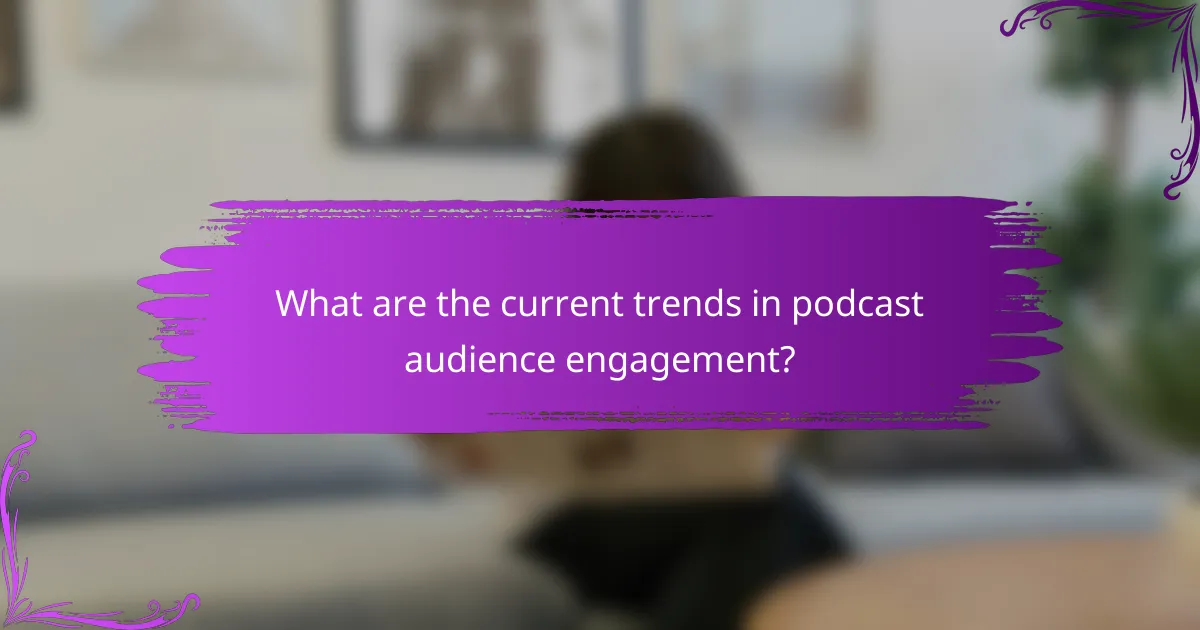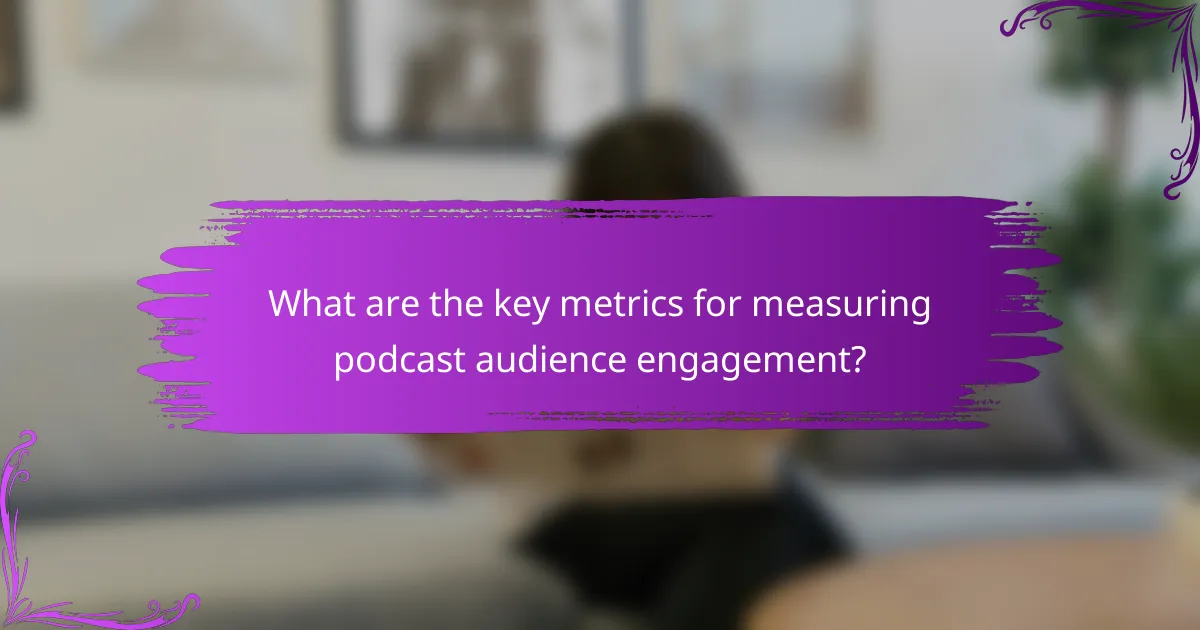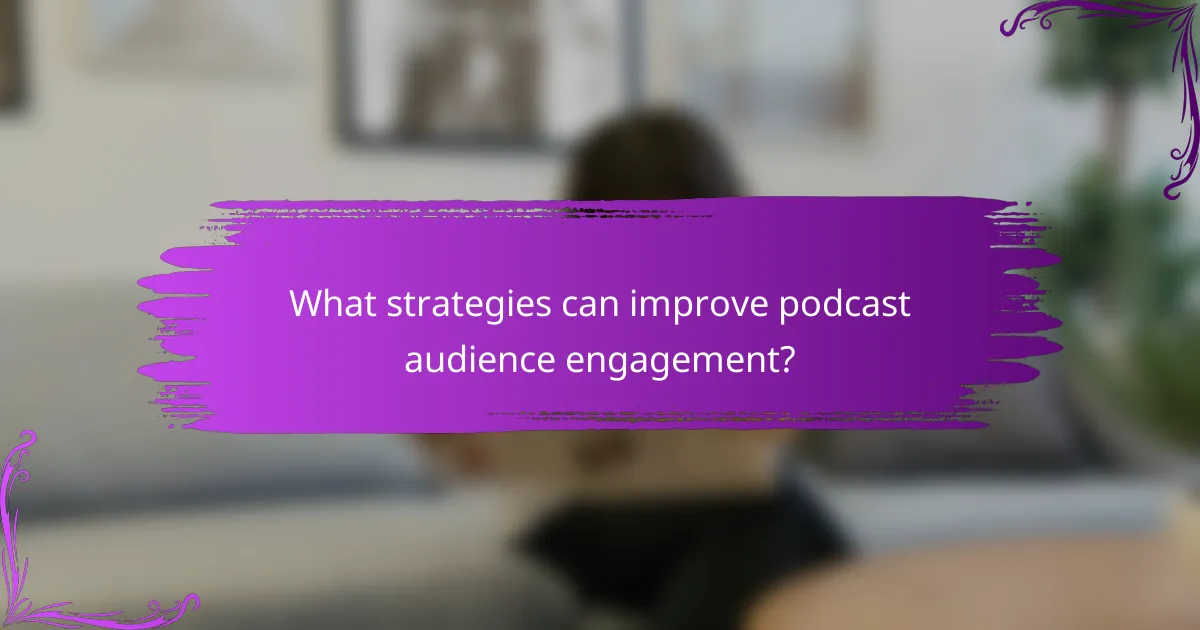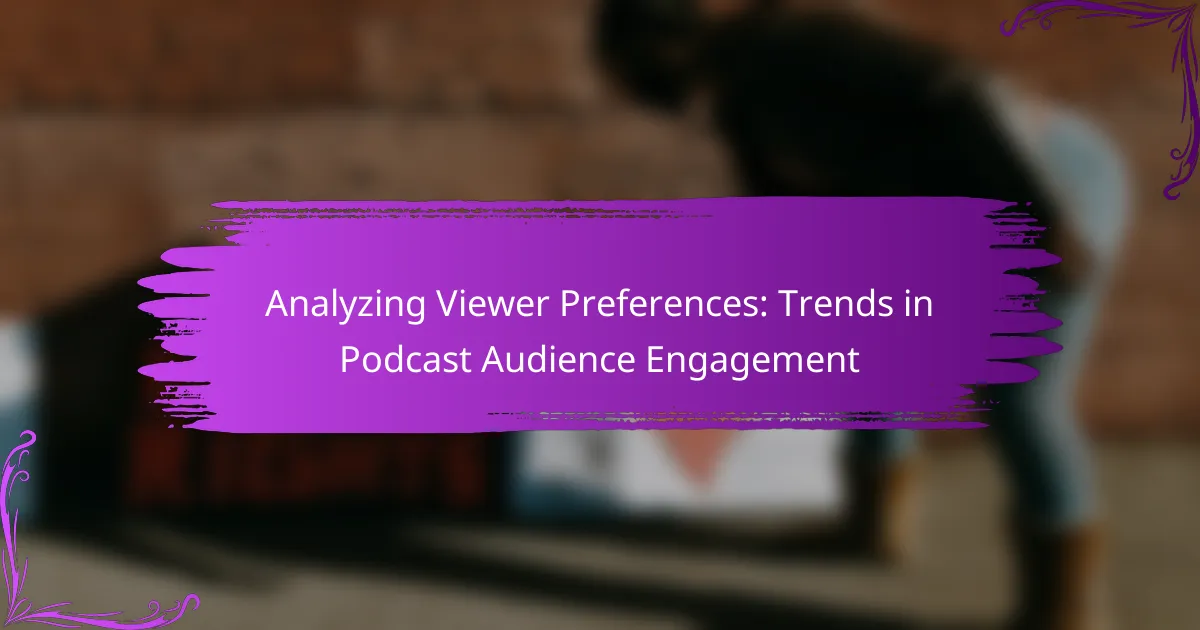
What are the current trends in podcast audience engagement?
Current trends in podcast audience engagement include increased interactivity and community involvement. Listeners are now participating through social media platforms. They engage by sharing feedback and discussing episodes online. Live podcast events are gaining popularity, allowing real-time audience interaction. Personalized content recommendations are enhancing listener experiences. Data shows that 54% of podcast listeners prefer shows that foster a sense of community. Additionally, the use of video podcasts is on the rise, attracting a wider audience. Brands are increasingly collaborating with podcasters for sponsored content, further engaging listeners. Overall, these trends indicate a shift towards more interactive and community-driven podcast experiences.
How has podcast audience engagement evolved over the years?
Podcast audience engagement has significantly evolved over the years. Initially, engagement was primarily measured through downloads and basic listener metrics. As technology advanced, platforms began offering more detailed analytics, such as listener retention and episode completion rates.
The rise of social media has further transformed engagement. Podcasters now interact directly with their audiences through platforms like Twitter and Instagram. This shift allows for real-time feedback and community building.
Live podcasting events have also gained popularity, enhancing audience interaction. According to a 2022 report by Edison Research, 70% of podcast listeners engage more when they can participate in live discussions.
Additionally, audience demographics have shifted. Younger listeners, particularly Gen Z, show higher engagement levels. They prefer interactive content and are more likely to share episodes.
Overall, the evolution of podcast audience engagement reflects advancements in technology and changing listener preferences.
What factors have influenced changes in audience preferences?
Changes in audience preferences are influenced by technological advancements, content variety, and social media engagement. Technological advancements, such as mobile devices and streaming platforms, have made podcasts more accessible. This accessibility has broadened the audience base. Additionally, the variety of podcast genres caters to diverse interests, attracting different listener demographics. Social media engagement allows for real-time interaction and feedback, shaping content direction. According to a 2021 Edison Research report, 41% of podcast listeners discovered new shows through social media. These factors collectively drive shifts in audience preferences, ensuring that content remains relevant and engaging.
How do demographic shifts impact podcast engagement trends?
Demographic shifts significantly influence podcast engagement trends. Changes in age, gender, and cultural backgrounds affect listener preferences and habits. For instance, younger audiences tend to prefer shorter, more dynamic content. In contrast, older demographics may favor longer, in-depth discussions.
According to Edison Research, in 2022, 62% of podcast listeners were between the ages of 18 and 34. This indicates a strong preference for content that resonates with younger audiences. Additionally, the rise of diverse voices in podcasting has attracted various demographic groups.
Listeners from different backgrounds engage with content that reflects their experiences. This shift encourages creators to tailor their content to specific audiences. As demographics evolve, so do the themes and formats that resonate with listeners.
What role does content quality play in audience engagement?
Content quality significantly influences audience engagement. High-quality content attracts and retains listeners. It fosters trust and credibility, encouraging audience loyalty. Research indicates that 70% of consumers prefer content that is informative and well-produced. Engaging content prompts discussions and shares, enhancing audience interaction. In podcasts, clear audio and relevant topics contribute to a positive listener experience. Quality content leads to higher ratings and more subscriptions, proving its impact on audience engagement.
How do storytelling techniques affect listener retention?
Storytelling techniques significantly enhance listener retention. Engaging narratives capture attention and create emotional connections. Research shows that stories improve memory recall by up to 22 times compared to facts alone. Techniques such as character development and plot structure make content relatable. This relatability encourages listeners to stay engaged longer. A study by the University of California found that well-crafted stories activate brain regions associated with emotion and empathy. These brain responses lead to better retention of information presented within the story. Therefore, effective storytelling is crucial for maintaining listener interest and enhancing memory.
What types of content are most appealing to podcast audiences?
Informative and storytelling content types are most appealing to podcast audiences. Audiences enjoy educational topics that provide insights and knowledge. These can include expert interviews, how-tos, and discussions on current events. Storytelling podcasts captivate listeners by weaving narratives that evoke emotions and relatability. True crime, personal stories, and fictional narratives often rank high in popularity. According to Edison Research, 60% of podcast listeners prefer shows that tell compelling stories. This data highlights the effectiveness of engaging content in retaining audience interest.

What are the key metrics for measuring podcast audience engagement?
Key metrics for measuring podcast audience engagement include downloads, listener retention, and listener demographics. Downloads indicate how many times an episode has been accessed. Listener retention measures the percentage of an episode that listeners consume. This metric helps identify how engaging the content is. Listener demographics provide insights into the audience’s age, gender, and location. These details help tailor content to specific audience segments. Engagement can also be gauged through social media interactions and listener feedback. Research shows that high retention rates often correlate with higher listener satisfaction.
How can listener feedback enhance content strategy?
Listener feedback can enhance content strategy by providing insights into audience preferences. This feedback allows content creators to tailor their material to meet listener demands. It helps identify popular topics and formats that resonate with the audience. Analyzing feedback can reveal gaps in content that need addressing. Engaging with listeners fosters a sense of community and loyalty. Research shows that 70% of content creators who utilize audience feedback see improved engagement metrics. This data underscores the importance of incorporating listener insights into the content development process.
What methods are effective for gathering listener insights?
Surveys and polls are effective methods for gathering listener insights. They allow direct feedback from the audience about their preferences. Online platforms can facilitate these surveys, ensuring wide reach. Social media engagement also provides valuable listener feedback. Analyzing comments and interactions can reveal audience sentiments. Focus groups offer in-depth discussions, uncovering nuanced listener opinions. Listening analytics tools track engagement metrics, providing data on listener behavior. These methods collectively enhance understanding of audience preferences.
How do listener ratings and reviews impact engagement?
Listener ratings and reviews significantly impact engagement. High ratings often lead to increased visibility in podcast directories. This visibility attracts new listeners who rely on ratings as a trust signal. Positive reviews can enhance a podcast’s credibility and encourage more downloads. Conversely, low ratings can deter potential listeners. Research shows that 70% of consumers trust online reviews as much as personal recommendations. Furthermore, engagement metrics like shares and comments often correlate with higher ratings. Overall, listener feedback shapes audience perceptions and influences overall engagement levels.
What analytics tools are available for podcasters?
Podcasters have access to several analytics tools to measure audience engagement. Popular options include Libsyn, Podbean, and Anchor. These platforms provide insights into listener demographics, episode performance, and download statistics. Additionally, Chartable offers advanced tracking and attribution features. Podtrac provides audience measurement and industry benchmarks. Google Analytics can also be integrated for website traffic analysis related to podcast content. These tools help podcasters understand listener preferences and improve their content strategy.
How do these tools measure audience behavior?
Audience behavior measurement tools utilize analytics to track engagement metrics. They analyze listening patterns, such as total listens and average listen duration. These tools also assess user interactions, including likes, shares, and comments. They can segment audiences based on demographics and preferences. Additionally, they monitor drop-off rates to identify where listeners lose interest. Data from these metrics helps creators understand content performance. For instance, a study by Edison Research found that 55% of podcast listeners engage more with shows that have interactive elements. This supports the effectiveness of audience behavior measurement tools in optimizing content strategy.
What specific metrics should podcasters focus on?
Podcasters should focus on metrics such as downloads, listener retention, and engagement rates. Downloads indicate the total number of times an episode is accessed. Listener retention measures how many listeners stay throughout the episode. Engagement rates reflect interactions, including shares and comments. These metrics help assess audience interest and content effectiveness. According to a report by Edison Research, 75% of podcast listeners listen to most or all of each episode, highlighting the importance of retention. Understanding these metrics allows podcasters to refine their content strategy and enhance audience engagement.

What strategies can improve podcast audience engagement?
Incorporating listener feedback is a key strategy to improve podcast audience engagement. This can be achieved through surveys and social media interactions. Engaging with listeners directly fosters a sense of community. Regularly addressing listener questions or comments in episodes enhances connection.
Creating compelling and relevant content is essential. Research shows that 60% of listeners prefer episodes that resonate with their interests. Consistency in episode release schedules also builds anticipation. Regular uploads help maintain audience interest and loyalty.
Utilizing storytelling techniques can captivate audiences. Engaging narratives keep listeners attentive and invested in the content. Inviting guest speakers introduces fresh perspectives and attracts new listeners. Collaborative episodes can expand reach and enhance credibility.
Incorporating multimedia elements, such as visuals or supplementary materials, can enrich the listening experience. This approach caters to diverse learning styles. Promoting episodes across various platforms increases visibility and accessibility.
Implementing interactive elements, like polls or live Q&A sessions, encourages real-time engagement. This strategy actively involves the audience in the podcast experience.
Overall, these strategies collectively enhance podcast audience engagement by fostering community, maintaining interest, and enriching content.
How can podcasters leverage social media for engagement?
Podcasters can leverage social media for engagement by sharing episode highlights and behind-the-scenes content. This strategy increases visibility and encourages audience interaction. Engaging with listeners through comments and messages fosters a sense of community. Polls and questions can be used to gather feedback and ideas for future episodes. Collaborating with other creators expands reach and introduces new audiences. Utilizing platform-specific features, like Instagram Stories or Twitter threads, enhances content accessibility. Statistics show that podcasts with active social media presence see higher listener retention rates. For instance, a study by Edison Research indicates that 54% of podcast listeners follow their favorite shows on social media.
What platforms are most effective for promoting podcasts?
Social media platforms are most effective for promoting podcasts. Facebook, Instagram, Twitter, and TikTok have large user bases. These platforms allow for targeted advertising and engagement with potential listeners. Additionally, podcast-specific platforms like Apple Podcasts and Spotify are crucial for visibility. They feature charts and recommendations that can boost listenership. Research indicates that 45% of podcast listeners discover new shows through social media. This statistic highlights the importance of leveraging these platforms for promotion.
How does audience interaction on social media influence engagement?
Audience interaction on social media significantly influences engagement by fostering a sense of community. When audiences engage through comments, likes, and shares, it creates a feedback loop. This interaction encourages content creators to produce more relevant material. According to a study by the Pew Research Center, 68% of social media users feel more connected to brands that engage with them. Increased interaction leads to higher visibility, as algorithms favor content with more engagement. Thus, active audience participation directly correlates with enhanced content reach and engagement metrics.
What are best practices for creating engaging podcast content?
Creating engaging podcast content requires a clear understanding of the audience and compelling storytelling. Identify the target audience to tailor content that resonates with their interests. Develop a strong narrative structure to maintain listener attention throughout episodes. Use high-quality audio equipment to enhance sound clarity and overall production value. Incorporate diverse formats, such as interviews, storytelling, and discussions, to keep content fresh. Engage listeners by asking for feedback and involving them in future topics. Consistency in publishing schedules helps build audience loyalty. Utilize social media to promote episodes and create a community around the podcast. These practices are supported by research indicating that audience engagement increases with personalized content and high production quality.
How can podcasters incorporate audience suggestions into their shows?
Podcasters can incorporate audience suggestions by actively soliciting feedback from listeners. They can use social media platforms to create polls or surveys. This allows listeners to share their ideas and preferences. Incorporating these suggestions can enhance audience engagement. For instance, a study by Edison Research found that 70% of podcast listeners enjoy when hosts address listener feedback. Podcasters can also dedicate segments of their shows to discuss audience suggestions. This approach fosters a sense of community among listeners. Additionally, responding to suggestions can build listener loyalty and retention.
What techniques can be used to maintain listener interest throughout episodes?
Engaging storytelling techniques can maintain listener interest throughout episodes. Utilizing cliffhangers at the end of segments encourages listeners to stay tuned. Incorporating diverse formats, such as interviews or panel discussions, adds variety and keeps content fresh. Regularly involving audience interaction through Q&A sessions enhances engagement. Using sound effects and music can create an immersive experience. Additionally, maintaining a consistent release schedule builds anticipation among listeners. Research indicates that podcasts with varied content types see higher retention rates. A study by Edison Research found that 80% of listeners prefer shows that keep them engaged with dynamic content.
What practical tips can podcasters implement to enhance engagement?
Podcasters can enhance engagement by incorporating listener feedback. Actively soliciting audience opinions can tailor content to their preferences. Additionally, creating interactive segments encourages participation. Polls and Q&A sessions foster a sense of community. Consistent episode scheduling helps establish listener habits. Engaging storytelling captivates audiences and keeps them invested. Utilizing social media for promotion increases visibility and interaction. Collaborating with guests can introduce new perspectives and attract their audience. These strategies are proven to boost listener retention and satisfaction.
The main entity of the article is podcast audience engagement. The article analyzes current trends in how listeners interact with podcasts, highlighting increased interactivity, community involvement, and the rise of live events and video podcasts. It discusses the evolution of audience engagement metrics, the impact of demographic shifts, and the importance of content quality and storytelling techniques. Additionally, it outlines effective strategies for enhancing engagement, including leveraging social media, incorporating listener feedback, and utilizing analytics tools to measure audience behavior.



